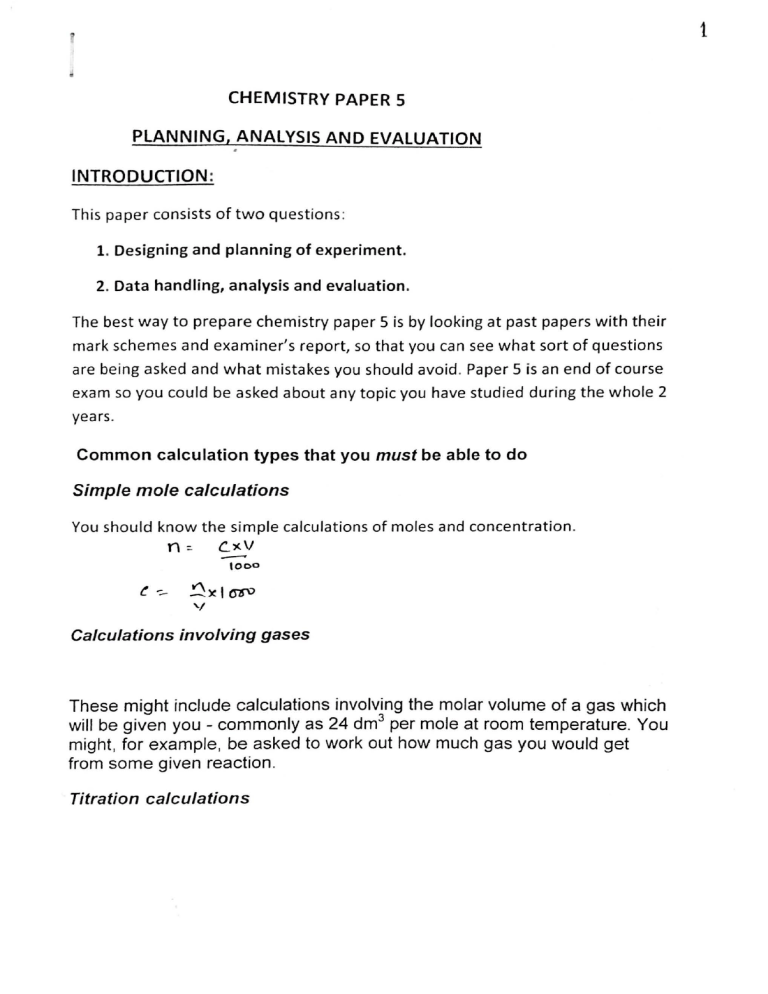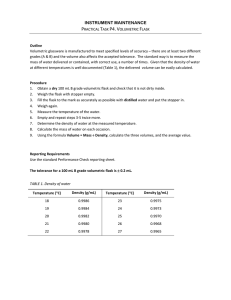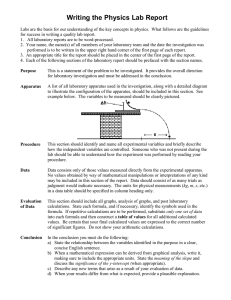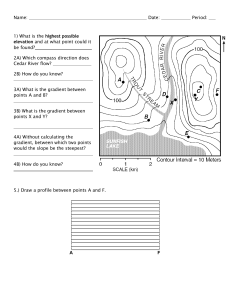
1
CHEMISTRY PAPER 5
PLANNING, ANALYSIS AND EVALUATION
.
INTRODUCTION :
Th is paper consists of two questions :
1. Designing and planning of experiment.
2. Data handling, analysis and evaluation.
The best way to prepare chemistry paper 5 is by looking at past papers with their
mark schemes and examiner's report, so that you can see what sort of questions
are being asked and what mistakes you should avoid. Paper 5 is an end of course
exam so you could be asked about any topic you have studied during the whole 2
years.
Common calculation types that you must be able to do
Simple mole calculations
You should know the simple calculations of moles and concentration .
n =-
-
c._~v
1000
Calculations involving gases
These might include calculations involving the molar volume of a gas which
3
will be given you - commonly as 24 dm per mole at room temperature. You
might, for example, be asked to work out how much gas you would get
from some given reaction.
Titration calculations
Enthalpy change calculations
Enthalpy is the amount of heat absorbed or evolved during a chemical reaction .
The unit of enthalpy is kj/mol.
This involves the relationship:
heat evolved = mass x specific heat x temperature rise
If heat is being absorbed, then the temperature will fall, but the equation
remains the same. The mass is strictly speaking the mass of everything being
heated which would have to be multiplied by all the individual specific heats,
but usually simplifications are used.
( t .... Adlly>t-\l~
~~c.t.·~)
( f_ ~7u. y ..,., ,;_,
{.~
c.l '~ .
APPARATUS AND THEIR CAPACITIES:
Always choose sensible apparatus in designing of experiments.
VOLUMETRIC APPARATUS AND ITS USES:
The apparatus in which we can measure the exact volume of a solution is called
volumetric apparatus.
Volumetric flasks
A volumetric flask is used to prepare fixed volume of a solution of known
concentration. It has various sizes but the one which we mostly use in labs is
250ml. If you are asked to make solution then always use volumetric flask. You
cannot use beaker or conical flask .
3
EXAMPLE:
Preparation of standard solution of NaOH:
For preparing 1 m 0 I
.
• .
ar so 1ut,on of NaOH dissolve 40g of solid sodium hydroxide in
lOOml of distilled water in a beaker, then transfer this solution and washings of
beaker in a 250ml volumetric flask and fill the flask up to 250 mark with distilled
water and shake the solution.
How to measure volume of a liquid or solution?
The most accurate apparatus used to measure the volume of a liquid is burette
and pipette. Measuring cylinders are not accurate enough so they cannot be used
for accurate volumes. They can be used in experiments where approximate
volumes of solutions are required.
APPARATUS
Surette
CAPACITY
50ml
Pipette
10ml and 25ml
Volumetric flask
250ml
Boiling tube
25ml
Test tube
16ml
Conical flask
250ml
Beaker
250ml and 500ml
Gas syringe
Measuring cylinder
Less than 500ml
10,25,50,100 and 250ml
Mass of a solid is measured by using weighing balance of accuracy O.Olg.
0
Temperature is measured by using thermometer (-lOc to llOc){-; I-
o e_)
DIAGRAMS:
When asked to draw diagrams always mention the volume of the apparatus being
used.
volumetric flask
C•O , 0J ;,,\
, '-' BU _.,
Gas syringe
.
)
-J
_APPARATu~
~A( O
Lj,f
-
~~-=::~~:....--
3t sf
~;de.
=====
a.-rvv, flt\~ k
(2, ~oc.ml)
/tpfA ~ATu s.
Fo/2.
HEAflN&, Sol1D
!/
APfAf!.ATv !;
BY
Fo~
HG..A: r, N. t;,,
ExArti ~£
=
.
l Hrzt fl1 AL-
.,.-,
A~µJ,-("14all)
to a.6~d"'lb
"I o2.-- ~ ~
-
•
C1)LLicT1Nb,
A:
s(J lJD_
f,,,f~
&,/tSfJ
~ Mf tJ lJJiD
/.1u1z-/<IY1AL
~
ru c(
7
p
0 M o~,Tio"'
of
AlecluJ1.c (Appa,u, 1:u.-1J.
(---loCib
LC\ ·()'\ p
L(/Yl
tioc..)
~ I~
'.J
aJ~~
OiJ
60 ;J;'u
6"1l-.-
po; J-
, l~
~
i-reA re-i.-
doy
/01,
io~IJ.1j'on.£
1hfa-L ·
ha.'1,1
1
e,- ~ - - -i'i \ / ,-..
- _
"'"'
d e.ilw d~ .
:tJL
w (
U\t1..ob
J
( R.u1. u d./m )
( ~od.P-)
(Ox.itkittm)
-,--_ LIA ~Cly U-l )
r Nlula.r t~~
MO so~
I Nl~r r J~~ .
ELE.c T/Zo Ly Tt. c__
crzLL
() F PofASs: ,oN1 Bi.lTt1"1E.QtoATE
C 1.f).. (,<J?J
2. H2-,b
-t
I
~
fL
-
C (~ L. L&'U IL
- e -( f 675 C,w\1)
~~t~
l ci.J-t '( co)
co\..,
C l- (./~
w
~~
w1~v{t~ ~ ~•
;,, eJ
-t
-t
HAZARDS AND PRECAUTIONS:
Most papers will have a question worth probably only a single mark asking
you to suggest necessary safety precautions during an experiment. All the
information needed is given to you, and it would be silly to waste this mark.
• Corrosive chemical: you need to avoid skin contact so wear gloves.
• Irritant chemical for skin and eyes: use gloves and goggles.
• Poisonous gases: use mask and perform the experiment in fume hood.
• Irritant chemicals for respiratory system: use mask and fume hood.
• Hot apparatus:_use heat proof gloves and hold the apparatus with pair of
tongs.
Flammable: Flammable means that a substance will catch fire if exposed to
a naked flame. Perhaps confusingly, inflammable means exactly the same
thing.
Obviously, here you have to keep the substance away from any naked flames.
If you had a flammable liquid, for example, you wouldn't want to heat it in a
test tube using a bunsen burner. Instead, you could heat it in a beaker of hot
water on an electric hotplate.
IJ
DATA HANDLING AND EVALUATION BY GRAPH
In this question some data is given in a table, you have to compl ete that table by
doing some calculations . Filling the columns in table be careful about the units
decimal places and significant figures. After calculations then you have to draw a
graph.
Which variable goes where?
The independent variable is the one which you are deciding to change. For
example, you might be measuring something at various different times which
you choose, or at various different temperatures, or at various different
concentrations. Each of these would be the independent variable.
The dependent variable is the one which changes because of the changes in
the independent variable. For example, the volume of a gas produced might
be dependent on how long the experiment is running for. The volume is
dependent on the time.
•
The independent variable goes on x-axis.
•
The dependent variable goes on y-axis.
•
70% graph should be covered.
•
Draw a best fit line or curve.
•
Draw a curve for solubility.
•
Draw specific graphs e.g order of reaction and titration curves.
Line of best fit means that all the points do not lie on the line. There are some
anomalous points lies above and below the line. These are the points which
deviate from best fit line due to some experimental errors. You have to encircle
clearly anomalous points on the graph.
Explain reasons for the anomalous points.
Point above the line: the y-axis variable (dependent variable) is greater than the
expected value.
Point below the line : y-axis variable is too low than the expected value.
You have to explain what the error might have been and why it made the point
too high or too low. For every experimental method there are different errors.
Measuring gradients
It is highly likely that you will be asked to measure the gradient (or slope) of
your graph. If you have a straight line, the gradient will obviously be for the
whole line. If it is a curve it will be at some point on the curve.
Measuring the gradient of a straight line.
The slope is measured by drawing a large triangle as shown below.
Examiners will expect you to make the triangle large to make measurements
more accurate.
;;E
S-
$1.opt.. ·. ~ '
c:
8i
"Lv. ,._,
e
}
6.y
0
(I)
E
:::,
-=-
-
C> i
( >~
t
~
mass of Mg (9)
The slope is given by the change in the y-axis value divided by the change in
the x-axis value - b..y/llx. In this case, it would be measured as volume of
hydrogen per gram of magnesium.
The examiners will almost certainly ask you to record the co-ordinates of the
points you have used to draw your triangle. They use these to check that you
have calculated the slope accurately.
Positive and negative gradients
If your graph is sloping upwards (as this one is), the gradient is positive. The
volume of hydrogen is increasing with the mass of magnesium.
If the graph is sloping downwards, then the gradient is negative, and that must
be shown in your answer. There is an example of this below.
L
ftft!Jst1ri11g the gradient of a curve.
Obviously, in this cas~, the slope is changing all the time, and so you will be
asked to find the gradient at some particular point.
•
To do that, you draw a tangent to the curve at the point, and use this to draw a
triangle similar to the one above.
1.0
0 .9
;;-
E
"C
0.8
0 .7
I
0 .6
0
0.5
C
..
.:s
l'CI
E
g,adient ,eq,i,ed at th,s pool
0 .4
s
0.3
8
0.2
C
I
0 .1
0
time (min)
In this case, the gradient would be recorded as the change in concentration
per minute at that point - again by measuring /j,_y/flx. But this time, the
concentration is falling with time, and so the gradient must be recorded as
negative. If you get the sign wrong, you will lose the mark.






